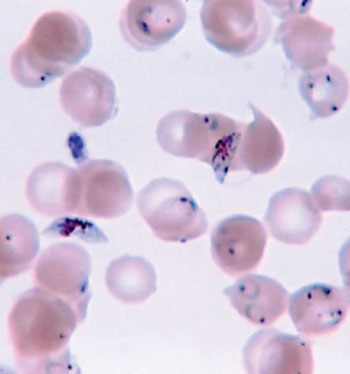Malaria Severity Not Determined Solely by Parasitemia
By LabMedica International staff writers
Posted on 26 May 2014
The relative contributions of such factors as the concentration level of malaria-causing parasites in a person's blood to disease severity and to development of protective immunity are not adequately understood. Posted on 26 May 2014
In areas where transmission is stable, severe malaria is unlikely to occur after five years of age, presumably as a result of immunity, and mathematical models suggest that protection against noncerebral severe malaria develops after one or two infections.

Image: A micrograph of a Giemsa-stained thin blood film showing a heavy infection of ring-forms and gametocytes of Plasmodium falciparum (Photo courtesy of Centers for Disease Control and Prevention).
A team of international scientists led by those at the US National Institutes of Health (Rockville, MD, USA) enrolled 882 newborns in the study as part of a longitudinal birth cohort between September 2002 and November 2005, in Muheza (Tanzania). Children were followed for an average of two years and for as long as four years. Children were examined at birth, once every two weeks during infancy, once every month after infancy, and during any illness. Blood smears were collected at all visits, regardless of whether symptoms were present.
Parasitemia was defined as any Plasmodium falciparum detected in a Giemsa-stained blood smear, and high-density infection requiring parenteral treatment was defined as a parasite density of more than 2,500 parasites per 200 white cells. P. falciparum-specific histidine-rich protein 2 plasma concentrations were determined during infection in all available samples from the cohort, which included 475 samples from the children who suffered severe malaria. Samples were tested using an in-house double-site sandwich enzyme-linked immunosorbent assay (ELISA). Hemoglobin type (HbAA, HbAS, and HbSS) was determined by cellulose acetate paper electrophoresis (Helena Laboratories; Beaumont, Texas, USA).
The scientist found that no simple relationship between parasite density and malaria severity emerged. Of the 102 children who did develop severe malaria at least once while enrolled in the study, almost two-thirds had high parasite density, but only mild disease either before or after the episode of severe malaria. This data suggest that one or two mild episodes of malaria are not sufficient to eliminate the risk of severe malaria which is contrary to predictions made by some mathematical models. The team noted that this prospective study is the first to provide direct evidence that severe malaria risk is stable over several infections.
The authors concluded they have provided direct evidence that severe malaria is unlikely to recur but that it commonly occurs after previous infections, including high-density infections. The immunity to severe malaria is not related to improved control of parasite density. The epidemiologic evidence suggests that naturally acquired immunity targets a conserved feature of the various severe-malaria syndromes, such as parasite virulence or host inflammation. The study was published on May 8, 2014, in the New England Journal of Medicine (NEJM).
Related Links:
National Institutes of Health
Helena Laboratories













